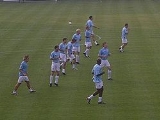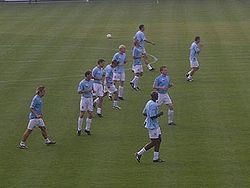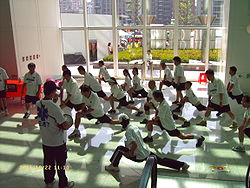
Warming up
Encyclopedia


Sport
A Sport is all forms of physical activity which, through casual or organised participation, aim to use, maintain or improve physical fitness and provide entertainment to participants. Sport may be competitive, where a winner or winners can be identified by objective means, and may require a degree...
s or exercising. A warm-up generally consists of a gradual increase in intensity in physical activity (pulse raiser), a joint mobility exercise, stretching
Stretching
Stretching is a form of physical exercise in which a specific skeletal muscle is deliberately elongated, often by abduction from the torso, in order to improve the muscle's felt elasticity and reaffirm comfortable muscle tone. The result is a feeling of increased muscle control, flexibility and...
and a sport related activity. For example, before running or playing an intense sport one might slowly jog to warm muscles and increase heart rate. It is important that warm ups should be specific to the exercise that will follow, which means that exercises (of warm up) should prepare the muscles to be used and to activate the energy systems that are required for that particular activity. The risks and benefits of combining stretching
Stretching
Stretching is a form of physical exercise in which a specific skeletal muscle is deliberately elongated, often by abduction from the torso, in order to improve the muscle's felt elasticity and reaffirm comfortable muscle tone. The result is a feeling of increased muscle control, flexibility and...
with warming up are mixed and in some cases disputed. Warming up prepares the body mentally and physically.
Benefits
A warm-up will improve the effectiveness of training and should be done before every training session. This is fundamental to a safe practice.Direct physical effects are:
- Release of adrenaline
- Increased heart rateHeart rateHeart rate is the number of heartbeats per unit of time, typically expressed as beats per minute . Heart rate can vary as the body's need to absorb oxygen and excrete carbon dioxide changes, such as during exercise or sleep....
- Enables oxygenOxygenOxygen is the element with atomic number 8 and represented by the symbol O. Its name derives from the Greek roots ὀξύς and -γενής , because at the time of naming, it was mistakenly thought that all acids required oxygen in their composition...
in the bloodBloodBlood is a specialized bodily fluid in animals that delivers necessary substances such as nutrients and oxygen to the cells and transports metabolic waste products away from those same cells....
to travel with greater speed - Increased production of synovial fluidSynovial fluidSynovial fluid is a viscous, non-Newtonian fluid found in the cavities of synovial joints. With its yolk-like consistency , the principal role of synovial fluid is to reduce friction between the articular cartilage of synovial joints during movement.-Overview:The inner membrane of synovial joints...
located between the joints to reduce frictionFrictionFriction is the force resisting the relative motion of solid surfaces, fluid layers, and/or material elements sliding against each other. There are several types of friction:...
- Allows joints to move more efficiently
- Enables oxygen
- Dilation of capillaries
- Enables oxygen in the blood to travel at a higher volume
- Increased heart rate
- Increase of temperature in the muscles
- Decreased viscosityViscosityViscosity is a measure of the resistance of a fluid which is being deformed by either shear or tensile stress. In everyday terms , viscosity is "thickness" or "internal friction". Thus, water is "thin", having a lower viscosity, while honey is "thick", having a higher viscosity...
of blood- Enables oxygen in the blood to travel with greater speed
- Facilitates enzymeEnzymeEnzymes are proteins that catalyze chemical reactions. In enzymatic reactions, the molecules at the beginning of the process, called substrates, are converted into different molecules, called products. Almost all chemical reactions in a biological cell need enzymes in order to occur at rates...
activity - Encourages the dissociationDissociation (chemistry)Dissociation in chemistry and biochemistry is a general process in which ionic compounds separate or split into smaller particles, ions, or radicals, usually in a reversible manner...
of oxygen from haemoglobin - Decreased viscosityViscosityViscosity is a measure of the resistance of a fluid which is being deformed by either shear or tensile stress. In everyday terms , viscosity is "thickness" or "internal friction". Thus, water is "thin", having a lower viscosity, while honey is "thick", having a higher viscosity...
within the muscle- Greater extensibilityExtensibilityIn software engineering, extensibility is a system design principle where the implementation takes into consideration future growth. It is a systemic measure of the ability to extend a system and the level of effort required to implement the extension...
and elasticityElasticity (physics)In physics, elasticity is the physical property of a material that returns to its original shape after the stress that made it deform or distort is removed. The relative amount of deformation is called the strain....
of muscle fibres- Increased force and speed of contractionMuscle contractionMuscle fiber generates tension through the action of actin and myosin cross-bridge cycling. While under tension, the muscle may lengthen, shorten, or remain the same...
- Increased force and speed of contraction
- Greater extensibility
- Decreased viscosity
- Increase of muscle metabolismMetabolismMetabolism is the set of chemical reactions that happen in the cells of living organisms to sustain life. These processes allow organisms to grow and reproduce, maintain their structures, and respond to their environments. Metabolism is usually divided into two categories...
- Supply of energy through breakdown of glycogenGlycogenGlycogen is a molecule that serves as the secondary long-term energy storage in animal and fungal cells, with the primary energy stores being held in adipose tissue...
- Supply of energy through breakdown of glycogen
- Increase in speed of nerve impulse conduction
- Removes lactic acid
A comprehensive warm-up programme has been found to decrease injuries in soccer.
Stretching
There are 2 types of stretches: ballistic stretchingBallistic stretching
Ballistic stretching is a form of passive stretching or dynamic stretching in a bouncing motion. Ballistic stretches force the limb into an extended range of motion when the muscle has not relaxed enough to enter it. It involves fast "bouncing" movements where a double bounce is performed at the...
and static stretching:
- Ballistic Stretches involves bouncing or jerking. It is purported to help extend limbs more during exercise to allow an individual to be more agile and flexible. However this type of stretching can cause injury and is not generally recommended.
- Static stretching involves flexing the muscles to help prevent injury and allow greater flexibility and agility. Note that some sources discourage static stretching as muscles are more prone to damage if stretched while cold. Static stretching for too long can also weaken the muscles temporarily.

